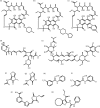In vitro activities of different inhibitors of bacterial transcription against Staphylococcus epidermidis biofilm
- PMID: 17606690
- PMCID: PMC2043205
- DOI: 10.1128/AAC.00343-07
In vitro activities of different inhibitors of bacterial transcription against Staphylococcus epidermidis biofilm
Abstract
Staphylococcus epidermidis is a major cause of nosocomial infections because of its ability to form biofilms on the surface of medical devices. Only a few antibacterial agents are relatively active against biofilms, and rifampin, a transcription inhibitor, ranks among the most effective molecules against biofilm-related infections. Whether this efficacy is due to advantageous structural properties of rifampin or to the fact that the RNA polymerase is a favorable target remains unclear. In an attempt to answer this question, we investigated the action of different transcription inhibitors against S. epidermidis biofilm, including the newest synthetic transcription inhibitors. This comparison suggests that most of the antibiotics that target the RNA polymerase are active on S. epidermidis biofilms at concentrations close to their MICs. One of these compounds, CBR703, despite its high MIC ranks among the best antibiotics to eradicate biofilm-embedded bacteria.
Figures



Similar articles
-
In vitro activity of a new antibacterial rhodanine derivative against Staphylococcus epidermidis biofilms.J Antimicrob Chemother. 2006 Oct;58(4):778-83. doi: 10.1093/jac/dkl314. Epub 2006 Jul 30. J Antimicrob Chemother. 2006. PMID: 16880176
-
Structure-activity relationships of phenyl-furanyl-rhodanines as inhibitors of RNA polymerase with antibacterial activity on biofilms.J Med Chem. 2007 Aug 23;50(17):4195-204. doi: 10.1021/jm0703183. Epub 2007 Aug 1. J Med Chem. 2007. PMID: 17665895
-
Antimicrobial activities of YycG histidine kinase inhibitors against Staphylococcus epidermidis biofilms.FEMS Microbiol Lett. 2007 Aug;273(2):149-56. doi: 10.1111/j.1574-6968.2007.00749.x. Epub 2007 Jun 18. FEMS Microbiol Lett. 2007. PMID: 17578527
-
Foreign body infections due to Staphylococcus epidermidis.Ann Med. 2009;41(2):109-19. doi: 10.1080/07853890802337045. Ann Med. 2009. PMID: 18720093 Review.
-
Staphylococcus epidermidis device-related infections: pathogenesis and clinical management.J Pharm Pharmacol. 2008 Dec;60(12):1551-71. doi: 10.1211/jpp/60.12.0001. J Pharm Pharmacol. 2008. PMID: 19000360 Review.
Cited by
-
Divide and conquer: the Pseudomonas aeruginosa two-component hybrid SagS enables biofilm formation and recalcitrance of biofilm cells to antimicrobial agents via distinct regulatory circuits.Environ Microbiol. 2017 May;19(5):2005-2024. doi: 10.1111/1462-2920.13719. Epub 2017 Apr 3. Environ Microbiol. 2017. PMID: 28263038 Free PMC article.
-
CBR antimicrobials alter coupling between the bridge helix and the β subunit in RNA polymerase.Nat Commun. 2014 Mar 6;5:3408. doi: 10.1038/ncomms4408. Nat Commun. 2014. PMID: 24598909 Free PMC article.
-
Antibiotic susceptibility of coagulase-negative staphylococci isolated from very low birth weight babies: comprehensive comparisons of bacteria at different stages of biofilm formation.Ann Clin Microbiol Antimicrob. 2010 May 27;9:16. doi: 10.1186/1476-0711-9-16. Ann Clin Microbiol Antimicrob. 2010. PMID: 20504376 Free PMC article.
-
Antimicrobial tolerance of Pseudomonas aeruginosa biofilms is activated during an early developmental stage and requires the two-component hybrid SagS.J Bacteriol. 2013 Nov;195(21):4975-87. doi: 10.1128/JB.00732-13. Epub 2013 Aug 30. J Bacteriol. 2013. PMID: 23995639 Free PMC article.
-
Totally implantable venous access port systems and associated complications: A single-institution retrospective analysis of 2,996 breast cancer patients.Mol Clin Oncol. 2016 Mar;4(3):456-460. doi: 10.3892/mco.2016.726. Epub 2016 Jan 7. Mol Clin Oncol. 2016. PMID: 26998304 Free PMC article.
References
-
- André, E., L. Bastide, S. Michaux-Charachon, A. Gouby, P. Villain-Guillot, J. Latouche, A. Bouchet, M. Gualtieri, and J. P. Leonetti. 2006. Novel synthetic molecules targeting the bacterial RNA polymerase assembly. J. Antimicrob. Chemother. 57:245-251. - PubMed
-
- Arhin, F., O. Belanger, S. Ciblat, M. Dehbi, D. Delorme, E. Dietrich, D. Dixit, Y. Lafontaine, D. Lehoux, J. Liu, G. A. McKay, G. Moeck, R. Reddy, Y. Rose, R. Srikumar, K. S. Tanaka, D. M. Williams, P. Gros, J. Pelletier, T. R. Parr, Jr., and A. R. Far. 2006. A new class of small molecule RNA polymerase inhibitors with activity against rifampicin-resistant Staphylococcus aureus. Bioorg. Med. Chem. 14:5812-5832. - PubMed
-
- Artsimovitch, I., C. Chu, A. S. Lynch, and R. Landick. 2003. A new class of bacterial RNA polymerase inhibitor affects nucleotide addition. Science 302:650-654. - PubMed
-
- Coronelli, C., R. J. White, G. C. Lancini, and F. Parenti. 1975. Lipiarmycin, a new antibiotic from Actinoplanes. II. Isolation, chemical, biological and biochemical characterization. J. Antibiot. 28:253-259. - PubMed
Publication types
MeSH terms
Substances
LinkOut - more resources
Full Text Sources
Other Literature Sources
Medical
Molecular Biology Databases

